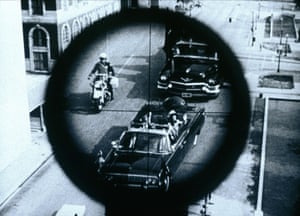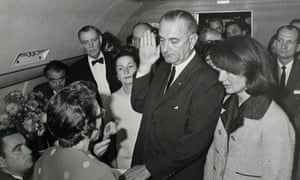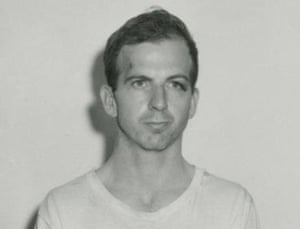Will the release of the latest cache of classified papers unleash a slew of books about the death of the charismatic Kennedy?

Oliver Stone’s film JFK suggested that the president was killed by a cabal of businessmen, gangsters, politicians, soldiers, Cuban dissidents and spooks. Photograph: Allstar/Cinetext/Warner Bros
If Lee Harvey Oswald was the sole figure involved in the assassination of President John F Kennedy (and hundreds of books have argued that he wasn’t), then he presumably fired his rifle from the Texas School Book Depository, because of the line of sight it provided on the route of the presidential motorcade through Dallas.
The choice of a warehouse containing educational texts has proved prophetic. When Oswald fired, he unleashed a towering stack of books arguing about the events of that day.
President Trump may hope that his order to publish the last trove of classified government documents will finally silence the literature of JFK-speculation. In fact, history suggests that the new wave of paperwork will provoke another rush of publications, or revisions to existing ones.
In a torrent of commentary equalled only by biblical scholarship, all Kennedy books are a response to a single previous volume: The Report of the Warren Commission: The Assassination of President Kennedy. Published in September 1964, this investigation concluded that Oswald had acted alone, firing two bullets into Kennedy’s head and neck.

If Lee Harvey Oswald was the sole figure involved in the assassination of President John F Kennedy (and hundreds of books have argued that he wasn’t), then he presumably fired his rifle from the Texas School Book Depository, because of the line of sight it provided on the route of the presidential motorcade through Dallas.
The choice of a warehouse containing educational texts has proved prophetic. When Oswald fired, he unleashed a towering stack of books arguing about the events of that day.
President Trump may hope that his order to publish the last trove of classified government documents will finally silence the literature of JFK-speculation. In fact, history suggests that the new wave of paperwork will provoke another rush of publications, or revisions to existing ones.
In a torrent of commentary equalled only by biblical scholarship, all Kennedy books are a response to a single previous volume: The Report of the Warren Commission: The Assassination of President Kennedy. Published in September 1964, this investigation concluded that Oswald had acted alone, firing two bullets into Kennedy’s head and neck.

Vice-president Lyndon Baines Johnson takes the presidential oath of office in Dallas, Texas, two hours after Kennedy was shot. Photograph: Reuters
Most publications have been sceptical of this finding. On the Trail of the Assassinsby Jim Garrison (1988), a Louisiana lawyer, and L Fletcher Prouty’s JFK: The CIA, Vietnam, and the Plot to Assassinate John F Kennedy (1992), featured key source material for Oliver Stone’s movie JFK (1991), which suggested that the president was executed by a vast cabal of businessmen, gangsters, politicians, soldiers, Cuban dissidents and spooks.
Most contributions to the JFK book depository have fingered at least some of the figures in the Garrison-Prouty conspiracy theory. The most recurrent prime suspect has been Cuba, which had been infuriated by the Bay of Pigs operation – Kennedy’s failed attempt to depose the Castro dictatorship through a CIA-run invasion by Cuban exiles. The communist island also features in Oswald’s still-mysterious trip, weeks before the Kennedy shooting, to Mexico City, where he apparently hoped to secure a visa to defect to Cuba.
Don DeLillo, after extensive reading of the 26 supporting volumes to the Warren report, presented Oswald in his 1988 novel, Libra, as the stooge of a CIA attempt to promote war with Cuba. James Ellroy’s American Tabloid (1995) begins with Castro’s coup and ends with the Dallas assassination, which the novel attributes to a conspiracy involving the Cuban interests of the CIA and the mafia.
Who Really Killed Kennedy? (2013), by Dr Jerome R Corsi, also finds the mafia guilty, although with a little help from Richard Nixon and the French. Another
work published to mark the 50th anniversary of JFK’s death, The Man Who Killed Kennedy: The Case Against LBJ, by Roger Stone, a Trump associate, implicates President Lyndon Baines Johnson, in close association with mobsters and US intelligence.
In 1974, Charles McCarry’s The Tears of Autumn suggests that the killing was ordered by South Vietnam in retaliation for the assassination of its president, Ngo Dinh Diem, during a coup engineered by the CIA in 1963. As McCarry was a former CIA agent, readers suspected that the writer was fictionalising privileged knowledge, although he has always insisted in interviews that it was just his theory.

Dallas Police Department photograph of Lee Harvey Oswald. Photograph: Reuters
But the most interesting of all the literary retorts to the Warren report is Norman Mailer’s Oswald’s Tale: An American Mystery (1995), which used KGB material released in post-Soviet Russia to illuminate the formative period that Kennedy’s presumed assassin spent in the USSR as a young man. However, despite this period deepening the mystery of Oswald’s motives, the generally anarchistic Mailer eventually concludes: “Every insight we have gained of him suggests the solitary nature of his act.” Mailer’s sly comparison of the assassination with masturbation underlines his theory that the killer was driven by narcissistic egotism, rather than an external commission.
The prominence of Mexico and Cuba in the Kennedy books means that those countries are likely to be among the most frequently searched words in the latest archive release. And those of us who find The Tears of Autumn the most plausible explanation of the assassination will look with particular interest at any CIA documentation dealing with Diem’s death.
These documents, though, are unlikely to be the last word. A quarter of a century ago, Gerald R Posner published a book – concluding that Oswald was a lone operator – that had perhaps the most falsely optimistic title in publishing history: Case Closed.
No comments:
Post a Comment